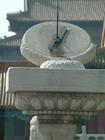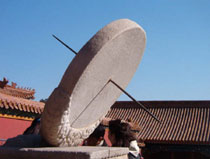你知道日昝吗?这是古代用来测量时刻的计时仪器。它由一根指针和一个圆盘组成。也许你会质疑这个仪器能计时吗?计时准确吗?这里我要告诉你它的精确度不输世界名表呢!事实上,表的设计原理是模拟了日昝的原理。下面就让我们来了解一下这个古老的报时器吧!

A sundial is a simple, yet accurate, instrument, which tells time by the movement of the shadow a pointer casts upon a dial, which marks the hours of the day. The shadow moves as the sun changes position in the sky throughout the day, and the dial tracks this movement.
For a sundial to be accurate, the pointer must be slanted at an angle equal to the latitude of its location. Vertical pointers are useful at showing the correct time only at one latitude and during one season, and flat dials must have unequally spaced hour marks upon them for accuracy.
Prior to the invention of the sundial, man guessed at the time of day by observing the sun's movement from morning until night. Sunrise and sunset required no calculation, but mid day, or noon, when the sun's position in the sky was at its peak, proved to be more difficult to predict. The times in between these three reference points left them baffled.
After scratching their heads for quite some time, it finally dawned on ancient man that shadows cast changed in length, and moved throughout the day. They concluded that, instead of craning their necks to watch the sun change position throughout the day, they could simply look down at the ground and note the passing of time by observing the change in shadow lengths. Additionally, this shadow clock method proved to be more accurate.

Prototypes of the sundial most likely consisted of poles stuck in the ground surrounded by rocks. The pole served as a pointer, and the stones as markers. The use of poles as pointers gave way to immense stone columns, one of which is Cleopatra's Needle in New York's Central Park. Sundials of smaller proportions were used, such as a "L" shaped Egyptian model dating back 3,000 years, which lays flat on the longer of its two legs, which bears marks indicating periods of time.
Around 300 BC, a Chaldean astronomer invented a bowl-shaped sundial with a pointer that cast a shadow onto the dial, which marked 12 hours of the day as the shadow inched along. Because this sundial proved to be highly accurate, its use continued for centuries.
More accurate, and portable, watches and clocks replaced sundials, as time telling instruments, but sundials still exist as ornamental additions to gardens. Oddly enough, some crude vertical sundials used for telling time, may be found on the walls and windowsills of old houses, and are configured so that a nail or the edge of the window casing casts a shadow. Perhaps, they served as the poor man's answer to the Swiss watch!
slant: (使)倾斜,歪向
Chaldean: 占星术的
( 英语点津 Annabel 编辑)
我想了解更多趣味百科知识